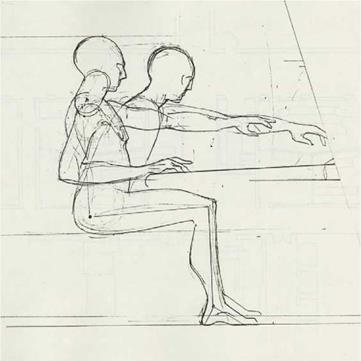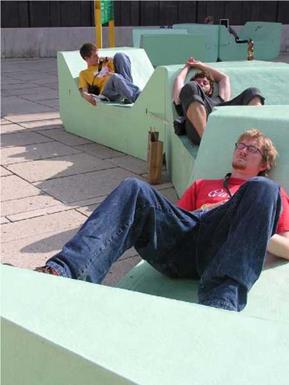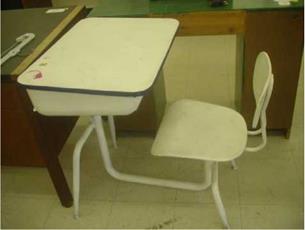Utility must precede beauty.
Christopher Dresser, "General Principles of Ornament," The Furniture Gazette, London, 1877, pp. 173-174.
Commodity (utilitas) is determined from a range of observations and experiences based on how well furniture functions and feels. In this book, commodity refers to comfort, ergonomics, social use, and the tactile experience of using furniture. It introduces ideas that contribute to an area of knowledge known as human factors, which involves scientific research on the interface between the human body and the built form. Human factors data are objective and scientifically determined, but the data are always subject to political and social frames of reference. Human factors encompass many areas of research, including accessible design, anthropomet – rics, ergonomics, posture, proxemics, and universal design.
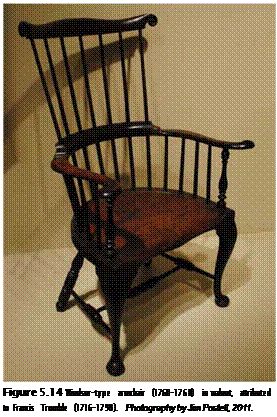
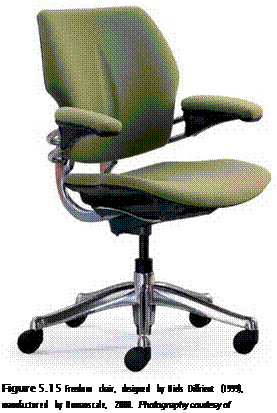 Human factors specialists are advocates for the user. Relatively expensive, mass-produced office chairs such as the Freedom chair (Figure 5.15) rely significantly on human factors research. Before the Freedom chair went into production, Humanscale invested in extensive anthropometric research and considered theories of ergonomics, body position, and body movement. Niels Diffrient designed the Freedom chair in 1999 for Humanscale. The chair’s headrest tilts forward as the sitter reclines, keeping the head in an upright position. The armrests adjust independently of one another as they pivot off the double spine that supports the chair’s backrest. Diffrient brought his background in industrial design and his engineering know-how to complement the need for an
Human factors specialists are advocates for the user. Relatively expensive, mass-produced office chairs such as the Freedom chair (Figure 5.15) rely significantly on human factors research. Before the Freedom chair went into production, Humanscale invested in extensive anthropometric research and considered theories of ergonomics, body position, and body movement. Niels Diffrient designed the Freedom chair in 1999 for Humanscale. The chair’s headrest tilts forward as the sitter reclines, keeping the head in an upright position. The armrests adjust independently of one another as they pivot off the double spine that supports the chair’s backrest. Diffrient brought his background in industrial design and his engineering know-how to complement the need for an
|
|
||
 ergonomic chair that emphasized the "human factors" in today’s office designs.
ergonomic chair that emphasized the "human factors" in today’s office designs.
Furniture physically and spatially embraces the body. One can sit and lie upon, work at, and touch furniture (Figures 5.16, 5.17, and 5.18). Designers need to experience their designs physically before they can accurately evaluate their work. Considering tactile experiences (haptic sensations) in design is important.
Ergonomics (i. e., fitting the task to work within the limits of the human body) presents challenges through which design is often evaluated. Commodity can be considered the interface between function and ergonomics. Design solutions seek to find a match between the measure and physiology of the body, the tactile experiences of use, and aspects of health, welfare, and pleasure.
Observing, documenting, and analyzing how people sit, reinforces compelling arguments for the need to maintain muscular strength, provide easy access, and allow for a range of postures and body movement while seated (Figure 5.19). Personal observations and individual inquiry may challenge traditional theories of ergonomics, which in the past attempted to facilitate static seated postures for extended periods of use.
Changing body postures, body movement, supporting the body’s weight, and maintaining lumbar lordosis are important aspects to
consider when designing a chair. Today, we understand more about the measure and physiology of the body than ever before. However, designers should remain open to new ideas about comfort and use, because our knowledge of ergonomics and human factors is in a constant state of flux.
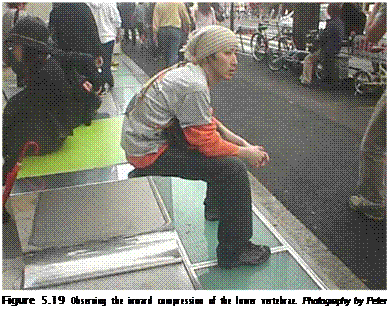 Anthropometries
Anthropometries
Anthropometrics is the science of determining anatomical measurements and understanding the physiology of the human body6 (Figure 5.20). Researchers working in the area of anthropometrics generate statistics from different age groups, body sizes, and body proportions, different ethnicities, gender distinction, and different populations to understand the similarities and differences in the human form. Knowledge of the physiology and measurement of the human body is critical for designing furniture. However, the application of anthropometrics does not require the designer to assume that comfort is scientifically achievable by "fitting" the structure and movement of the body with furniture. Nonetheless, anthropometric data are an important resource for furniture designers and are helpful in determining the dimension, size, and material of furniture designs.
The following questions utilize anthropometric data in their response:

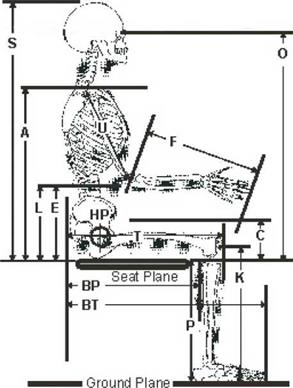 Key
Key
S sitting height (erect)
S sitting height (normal)
О ocular (eye) height
A acromion (shoulder) height
U upper arm length
F forearm length
L lumbar height
E elbow height
C thigh clearance (under table)
К knee (patella) height
P popliteal height
BP buttocks – popliteal length
DT buttocks-toe length
■ 
What is a reasonable height of a chair’s seat pan for the average adult?
■ What is the height of the seat pan relative to the length of the body’s popliteal dimension?
■ What is a reasonable angle of the seat rake for reading?
■ How might the choice of materials contribute to the experience of sitting?
■ What is a reasonable height of a table surface for dining for an average man, woman, child, or adult in a wheelchair?
■ Where on the body is the vascular flow most susceptible to outside pressure?
Body posture and appropriate support are some of the many dependent relationships that furniture designers need to consider (Figure 5.21), and one can analyze these in plan as well as section. To help determine dimensions, materials, and form, designers may inquire: What is the intended purpose of the chair or table? Who are the intended users? How will the furniture be used? The significance of these questions becomes evident when a chair or table is designed for the first time.
Anthropometries is a term that industrial designers, interior designers, engineers, and architects share with researchers working in the area of human factors. The works of Henry Dreyfuss, The Measure of Man (1960), Human Scale (1974; reissued in 1981 with his protege, Niels Diffrient), and The Measure of Man and Woman (revised edition, 2002) are important in the field of anthropometrics. Human Scale was a significant step forward in the process of documenting the physiology and measurement of the human body. Although Dreyfuss initially emphasized white males in gathering data on the physiology and measurement of the human body, his research expanded and eventually included the physiology and measurement of women in the revised edition of The Measure of Man and Woman. The revised work presented a statistical analysis of the human body in a range between the 5th and 95th percentiles of the American population. This extensive range (90 percent of the population) contributes to our understanding of the measurement and physiology of the human body and establishes a political and social context of an extent that design ought to accommodate.
This work, and the work of others, has challenged preliminary theories of ergonomics, advancing a collective understanding about design in general relative to the physiology and measurement of the human body. Researchers have also investigated the space that sitting in different postures occupies in both plan view and section (Figure 5.22). Furniture designers should seek to understand as much as possible regarding the physiology and measurement of the human body and its interface with built form. One opportunity in this regard is to enable more movement and variation of posture into chair designs. Another option is for everyone to spend less time sitting.
The following list outlines dimensional and quantitative characteristics of the human body:[1]
 General Body Characteristics and Dimensions
General Body Characteristics and Dimensions
■ Surface area of the skin: Adult males 2.2 m2, females 1.9 m2
■ Weight: Adult males 110-215 lbs; females 92-175 lbs
■ Standing height: Adult males 68.3 inches; females 62.9 inches; boys (age 12) 58.8 inches; girls (age 12) 58.8 inches
■ Eye height (standing): Adult males 64.7 inches; females 60.3 inches
■ Eye height (sitting): Adult males 31.3 inches; females 29.3 inches
■ Overhead reach: Adult males 88.0 inches; females 79.0 inches
■ Popliteal height: Adult males 17.3 inches; females 15.7 inches
■ Buttock-to-knee length: Adult males 23.3 inches; females 22.4 inches
■ Buttock-to-popliteal: Adult males 19.5 inches; females 18.9 inches
■ Knee height: (sitting): Adult males 21.4 inches; females 19.6 inches
■ Eyebrow-to-fingertip: Adult males 19.0 inches; females 17.4 inches
■ Shoulder breadth: Adult males 17.9 inches; females 15.7 inches
■ Foot length: Adult males 10.4 inches; females 9.4 inches
■ Breaths per minute at rest: Adult males 14-18; females 20-22
■ Street clothes for men weigh: Adult males 5 lbs; females 3Уг lbs
■ Winter clothing: Adult males 10 lbs; females 7 lbs
Strength
■ Left arm is generally 10 percent weaker than the right arm.
■ Male strength increases the first 20 years, holds between 5 and
10 years, then gradually decreases. Between the years 15 and 20, Figure 5.22 Technical body, motion, and study of males are at their maximum strength. At 60 years, males are 25 sitting dimensions (P|an and elevation). image percent less strong than at their original peak. courtesy of Peter Chamberlain in proxy for
Dr. Jirou Ohara.
■ Females reach their peak at age 30. Women are generally 30-35 percent less strong than men
■ Tallest man: 8 ft 11 inches; tallest woman: 7 ft 7.25 inches
■ Smallest man: 26.5 inches; smallest woman: 23.4 inches
■ Average U. S. adult is growing taller at a rate of 0.4 inches (1 cm) per decade.
■ Strength is affected by altitude; 15 percent loss at 10,000 ft, 40 percent at 29,000 ft.
The Spine and Vertebrae
■ Cervical vertebrae: The vertebrae in the neck area of the backbone.
■ Thoracic vertebrae: The 12 vertebrae in the chest area of the backbone
■ Lumbar vertebrae: The 5 vertebrae in the abdominal area of the backbone.
■ Sacral vertebrae: The "tailbone," which is composed of the sacrum and coccyx fused together.
Basic Terms with their Definitions
■ Isometric strength: The maximum force that muscles can exert when muscle length changes
|
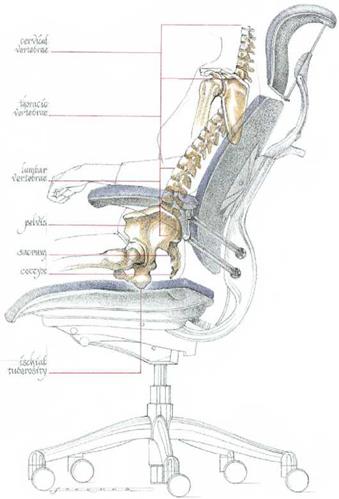
■ Concentric force: The force exerted when the muscle is shortened against an external force.
■ Effort: physiological strain, both static and dynamic.
■ Work: dynamic effort.
■ Endurance: the ability to continue work or exert force.
Work Output
■ Sleeping: 65 calories per hour
■ Walking slowly: 200 calories per hour
■ Walking up stairs: 1,100 calories per hour
■ Energy consumption per day: 3,450 calories
■ 8 hours of sleep: 520 calories
■ 3 hours of light work: 510 calories
■ 8 hours of medium work: 1,920 calories
■ 5 hours of sitting: 500 calories
Ergonomics
The study of ergonomics focuses on work and how work is done. It seeks to establish a healthy fit between performing a task, the limits of the human body, and parameters established in the designed product (Figure 5.23). This thesis is based on the assumption that the
body is healthier if it is not stressed beyond the normal limits of muscle, bone, posture, and so on. The term ergonomics entered the modern lexicon when Wojciech Jastrzebowski used it in an 1857 article on the subject.7 Since then, ergonomics has often been used synonymously with the total application of human factors, including the terms universal design and accessible design, but semantic distinctions between these terms are important to understand.
The term ergonomics comes from the Greek words ergos, meaning "work," and nomoi, meaning "natural laws." An ergonomic design solution adapts the task to fit the natural limits of the person rather than forcing the limits of the person to conform to the task or the design. The goal of ergonomics is to optimize how well design (or habits) can enable work to be accomplished, considering the physical and psychological limits of the human body. Body posture and the physical limits of reaching, pulling, lifting, and pushing are factors to consider in ergonomic design.
Many office chairs are labeled and branded as ergonomic seating. A chair is ergonomic only when the limits of the user correlate with the task at hand. A chair with a right-handed tray is not ergonomic for a left-handed user, and fixed auditorium seating is not ergonomic for interactive class discussions. The term ergonomics applies to experiences and tasks (which are temporal) and less directly to objects and furnishings.
Consider ergonomics by looking at its prefix, erg, a unit of measure of work or energy, and render the suffix, nomics, as having to do with efficiency. A body of knowledge regarding the efficiency of work grew out of funded research for the U. S. military in the 1940s and 1950s. This research was extended to include the study of blue-collar work considerations in the 1960s and eventually to white-collar office environments in the 1970s. In the 1980s, with the introduction of computers and other equipment into the workplace, ergonomic research concentrated on repetitive strain injuries as well as neck and lower back disabilities caused by poor spatial arrangements, inflexible furniture and equipment, and poor work habits. Ergonomic research responded to the growing cost of injuries and disabilities that occurred in factories, laboratories, and office environments.
In recent years, there have been dramatic increases in cumulative trauma disorders (CTDs), repetitive motion disorders, and other work-related injuries and illnesses due to ergonomic hazards. These injuries, which affect the musculoskeletal and nervous systems, may be caused or aggravated by repetitive motions, forceful exertions, vibration, mechanical compression, hard surfaces, and sustained or awkward postures held for extended periods of time. CTDs affect nearly all tissues. Nerves, tendons, tendon sheaths, ligaments, and muscles are frequently injured by poor furniture design and poor use. CTDs are recognized as a significant health hazard in the workplace and account for the largest share of occupational illnesses known as repeated trauma disorders, according to the Bureau of Labor Statistics.8 Today, the need to make work efficient incorporates concern for making work and the tools used to work with more healthful, safe, and environmentally green.
Furniture designed from an ergonomic perspective focuses on task-specific operations. Ergonomic research also considers multiuse and multiusers. Ergonomic furniture is marketed to businesses where liability and public welfare are of concern and functions such as typing, lifting, and pulling may cause medical problems. Smart seating, adjustable work surfaces, wrist relaxers, posture guidelines for working at a computer keyboard and monitor, policy concepts regarding the need to take breaks, the importance of vascular circulation, and body movement have been introduced and integrated into ergonomic research topics. The Ergonomics Data Sheet compiled by the U. S. Department of Labor in 1989 states that, "ergonomists, industrial engineers, occupational safety and health experts, and other
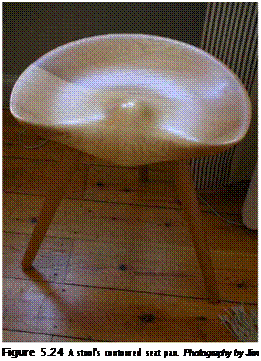 trained individuals believe that at least one-half of all workplace safety and health problems could be reduced by changes in ergonomic conditions."9 Nearly all of the ergonomic changes proposed by the Department of Labor impact the design and use of furniture.
trained individuals believe that at least one-half of all workplace safety and health problems could be reduced by changes in ergonomic conditions."9 Nearly all of the ergonomic changes proposed by the Department of Labor impact the design and use of furniture.
The size, material, and form of chairs should provide ergonomic support and utilitarian function. Dimensions of the user and operative tasks are important considerations in chair design. In addition, four utilitarian factors ought to be considered when designing human body supports:
1. Supporting the weight of the user
2. Eliminating pressure points
3. Enabling body movement
4. Maintaining lumbar lordosis
Supporting the weight of the user: The first consideration is how to support the weight of the user for the task at hand. Traditional views suggest that ergonomic seating should distribute the weight of the user evenly. However, supporting the body is often limited to selective areas: the lower back, ischial tuberosities, and arms. The seat rake is the angle of the seat back to the seat pan. Designers and ergonomic researchers study the correlation between seat rake and posture. Studies of different seating profiles, including Clara A. Ridder’s body-neutral posture research (resulting in the Ridder Curve),10 are important to consider in chair design. Further, an inclined seat back may help distribute the weight of the body.
Eliminating pressure points: A second consideration is the need to eliminate or minimize pressure points. Pressure points can constrict the flow of blood through the body and can affect the nerves that transfer sensation to the brain. This can cause discomfort, lead to the sensation of pins and needles, paresthesia,11 and eventually lead to numbness. The area behind the knee is particularly sensitive to pressure and applied force. In ergonomic seating, a waterfall seat front, a seat height that is no higher than the popliteal dimension, an upholstered seat, or a contoured seat pan are strategies to minimize uncomfortable pressure points while being seated (Figure 5.24).
There are two triangular seat bones inside the buttocks called ischial tuberosities. Research indicates that approximately 65 percent of the body’s weight is transferred through these bones to the seat of the chair when sitting.12 The shape, angle, and curvature of the seat pan affect the amount of pressure applied to these two bones when sitting. The height of the seat pan ought to be slightly less than the length behind the user’s knee to the floor. The vertical dimension from the underside of the thigh at the knee to the bottom of the foot on the floor is the popliteal dimension. After adjusting for heels, clothing, and other issues, the popliteal dimension is useful in determining the height of the chair seat. The height of the seat pan in mass-produced chairs is generally 17 inches (43.2 cm)—falling in the middle of the American National Standards Institute (ANSI) recommendation for the range of seat height adjustment: 15 to 20Уг inches (38.1 to 52 cm).13 It is critical that the seat pan be no higher than the popliteal dimension of the user. Traditional theories suggest that the feet ought to rest firmly on the floor. This will minimize pressure
points, increase the stability of sitting, and help distribute the weight of the body more evenly. In theory, consider a 135-degree angle between the spine and the thighs as a place to start, bringing the knees significantly below the seat pan. This angle places the pelvis and spine in a body-neutral position; however, very few chairs accommodate this angle. A different but related angle to consider is the seat-to-back angle, which generally ranges from 95 to 105 degrees. ANSI recommends that this angle be between 90 and 105 degrees.
Enabling body movement: A third ergonomic consideration is to enable body movement while being seated. Though posture is dependent on time and societal norms, it is not a static condition. The human body is always moving, seeking comfort and different positions when sitting, resting, or sleeping. Without movement, our muscles would not be allowed a certain degree of activity, and that would result in signals being sent to our nerve center telling us that we uncomfortable. Consider chair designs that allow people to distribute their weight, adjust their posture, and use their muscles when sitting. Designers should allow enough space and appropriate body support in their designs to enable a variety of body postures for the body and for body movement.
Maintaining lumbar lordosis: The fourth aspect to consider in supporting the human body is the curvature of the lower lumbar vertebrae and the angle of the hip when seated. Contemporary theory seeks to maintain lumbar lordosis while seated, which is the natural curvature of the spine when standing. When the lower lumbar vertebrae are compressed forward (which occurs when sitting on a flat surface), they become pinched. This can be painful and harmful to the fourth and fifth lumbar disks over time. Inward compression of the lower lumbar vertebrae results when leaning forward over a desk or work surface. This results in the flattening of the lumbar curve, which is called kyphosis. Designers should avoid this condition through design whenever possible and consider ways of maintaining lumbar lordosis for the seated user. Rotating the pelvis forward helps maintain the natural curvature of the spine.14
Moving from a standing position (lumbar lordosis) to an upright sitting position bends the hip joint and rotates the pelvis, flattens the lumbar curve (kyphosis) of the back, and strains the muscles in this region. One should consciously maintain a wide angle between the torso and the thighs in design, and in doing so, attempt to maintain lumbar lordosis for the user while in a seated position.
Though ergonomic criteria are critically important aspects in designing a chair, this does not mean that other criteria are of less importance. Related to ergonomics is the subject of posture and the various positions assumed by the human anatomy when sitting or supported by furniture.
Posture
Furniture affects posture, which in turn, influences how people sit, work, rest, and socially gather. Conversely, observing how people naturally sit, work, and rest can inspire design ideas (Figure 5.25). Posture expresses cultural, societal, and gender-based considerations. Posture also reveals formal and informal patterns of behavior, spatial communication, and social interaction. An ideal posture does not exist because human beings cannot hold any single posture for long periods of time. Posture is always changing, driven in part, by the need to redirect the flow of blood and relieve pressure applied to the body over time. How people communicate in and through space and how people sit directly affect how well furniture functions and feels.
|
|
|
|
Figure 5.27 Body posture profile studies. Image courtesy of Peter Chamberlain in proxy for Dr. Enshu Moritani. Image source: Enshu Moritani.
Posture is a concept that reveals continuous body movement when sitting, standing, or walking. The position of the body is always shifting to seek comfort. Posture expresses social – spatial communications between people, driven by cultural norms, and physiological factors. An interesting aspect of posture to consider in design is the influence that our legs and feet have upon body posture. What people do with their legs and how people control their feet are important criteria in the design of a chair, stool, or sofa. When people sit upright to work or concentrate, their legs and feet are naturally pulled back under the seat pan of the chair, and often assume the lowest possible position, limited in most cases by the floor itself. Inversely, when people recline in a relaxed posture, the natural tendency is to stretch out the legs and feet in a raised and supported posture.
Poor posture has been a factor in litigation cases involving worker’s compensation claims and loss of income due to medical disabilities resulting from improper design and use. Poor work habits and bad posture contribute to physical problems with the back, neck, and wrists, which motivates further research on ergonomics and posture.
During the twentieth century, chairs and desks in schools were designed to keep the body and eyes forward and to place the hips, knees, and ankles mostly at right angles in an upright-seated position, with feet firmly planted on the ground. Often, desks and chairs were integrated with one another (Figure 5.26). Today, this is not considered a healthful design. The integration of chair and desk offers little flexibility of use. Further, it is difficult to maintain a static or fixed position for a substantial period of time.
Research studies during the past 20 years have pointed out that when sitting in this manner, the hip joints actually bend only 60 degrees. An additional 30 degrees of bending occurs in the lumbar region of the lower back.15 This bending straightens the lumbar vertebrae, straining muscles in this critical region. Figure 5.27 shows how the angles of the hip,
Figure 5.29 Denmark’s International Study Program: Summer Furniture Design Workshop—chair designed and fabricated by Jessop Kozink. Photography by Bjorli Lundin.
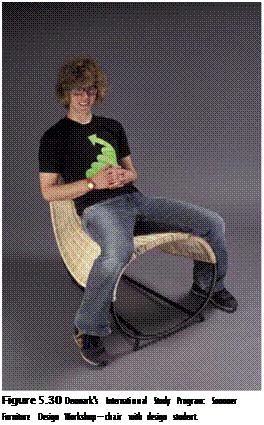
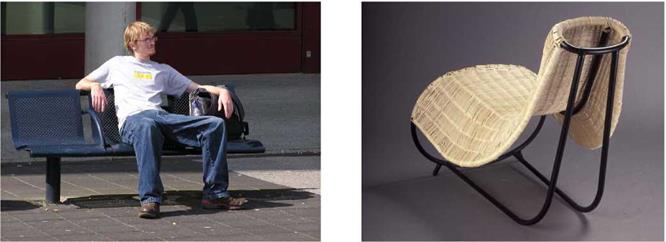 |
knee, and back correlate with one another in different postures ranging from standing to lying down (with and without body support).
Contemporary thinking suggests that a sitting posture in a natural resting position is healthful (Figure 5.28). This allows the spine to carry the body’s weight in a more comfortable way. This concept has been called balanced seating, a term coined by A. C. Mandel, chief surgeon of the Finsen Institute in Copenhagen, Denmark.16
Correlations between a chair’s formal characteristics and body posture, use, and comfort are important factors to investigate. The paired images in Figures 5.29 through 5.32 reveal interesting correlations between chair designs and body postures. The chairs were designed and fabricated by students enrolled in Denmark’s International Study Abroad Program (DIS) summer furniture workshop taught at the Danmarks DesignSkole in Copenhagen. For ten years since the year 2000, Professors Erling Christoffersen,
Flemming Jensen, and Bjorli Lundin taught a summer workshop in which design students from different American programs design and fabricate a chair (human body support). The choice of what to design and fabricate was left to the students, but the designs had to utilize one primary material: a limited amount of veneer, lumber, or metal rod. The images of the chairs paired with the images of students sitting on their chair designs reveal interesting correlations between furniture, posture, and design intention.
Proxemics
Proxemics is the study of how people communicate in and through space. It links the study of human behavior with social, cultural, spatial, and geographic contexts. It is an area of study that considers eye contact, body language, posture, and social customs, as well as
|
 |
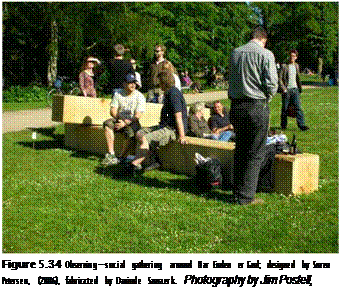 |
Figure 5.32 Denmark’s International Study Program: Summer Furniture Design Workshop—chair with design student. Photography by Bjorli Lundin.
intimate, personal, social, and public spatial zones of interaction and communication (Figures 5.33 and 5.34). Notions of privacy, intimacy, crowding, defensible space, and territoriality are aspects to consider when arranging furniture in space.
Benches designed by Gunnar Asplund for one of the grieving chapels at Skogskyrkogarden (Woodland Cemetery in Stockholm, Sweden), have a 15-degree angle incorporated in plan, dividing and joining the benches into two nonsymmetrical parts. This angle promotes eye and body contact better than a conventional bench would and symbolically draws together two parts into a whole (Figure 5.35).
The term proxemics is attributed to the research and writing of anthropologist Edward T. Hall.17 In 1963, Hall described the measurable distances between people as
they interacted. Hall’s work in the areas of sociology and anthropology was reinforced and developed further by the research and writing of psychologist Robert Sommer, Donald Preziosi, and the video documentaries of William Whyte.
 Cultural and societal notions of how people interact with one another and their patterns of behavior are important to understand. The size, location, and orientation of furniture directly influence patterns of behavior. Seating and table arrangements can influence the perception of space and contribute to the social and psychological experience of space.
Cultural and societal notions of how people interact with one another and their patterns of behavior are important to understand. The size, location, and orientation of furniture directly influence patterns of behavior. Seating and table arrangements can influence the perception of space and contribute to the social and psychological experience of space.
For example, crowding is known to increase irritation and stress, leading to friction, arguments, and even crime.18 Curiously enough, crowding is not entirely dependent on density; rather, it has to do with one’s personal ability to maintain a sense of control in a given spatial context for a period of time. Crowding is a mental construct of how people react to a given situation as much as it is a quantitative measure of the density of people per square foot. Configuring furniture in a classroom or restaurant into clustered arrangements can help reduce the perception of crowding. Furniture designers need to understand the social grouping dynamics and behavior patterns of those who will use their designs as much as they need to understand code regulations and occupancy standards when organizing and composing furniture in space.
In The Hidden Dimension, Hall pointed out that social distance between people could be measured and described in four categories:
■ Intimate distance for embracing, touching, or whispering (6-18 inches or 15.2-45.7 cm)
■ Personal distance for interactions among good friends (1.5.4 feet or 0.45.1.21 m)
■ Social distance for interactions among acquaintances (4-12 feet or 1.21-3.65 m)
■ Public distance used for public speaking (12 feet or over 3.65 m)
The idea of navigating through one’s environment and the environments of others, including the cultural nuances in how people interact with one another, contributes to the study of proxemics.
Hall recognized that different cultures maintain different standards of personal space.19 Proxemics concentrates on places and spaces where people congregate or pass through, such as airports, lobbies, and plazas, as well as private spaces, personal residences, and office environments. Design can influence how people communicate in and through space, depending on the public or private setting, the people in the study, the characteristics of the furnishings, and the placement and orientation of the furnishings.
Reflect upon the traditional elongated, rectangular dining table. The table’s form suggests a social hierarchy revealed through the correlation of its dominant axis and the
place where the "head" of the household traditionally sits. Compare a rectangular dining table to a circular table, where there is no dominant axis (Figure 5.36). One might infer that primary and secondary orders, relative to spatial layout, suggest primary and secondary orders relative to social status. One can conclude that a circular table expresses an equitable group sharing without bias the collective activity of working, talking, or eating. Following this line of thought, one might begin to see political, social, cultural, and gender-biased intentions in the conception and development of other pieces of furniture.

